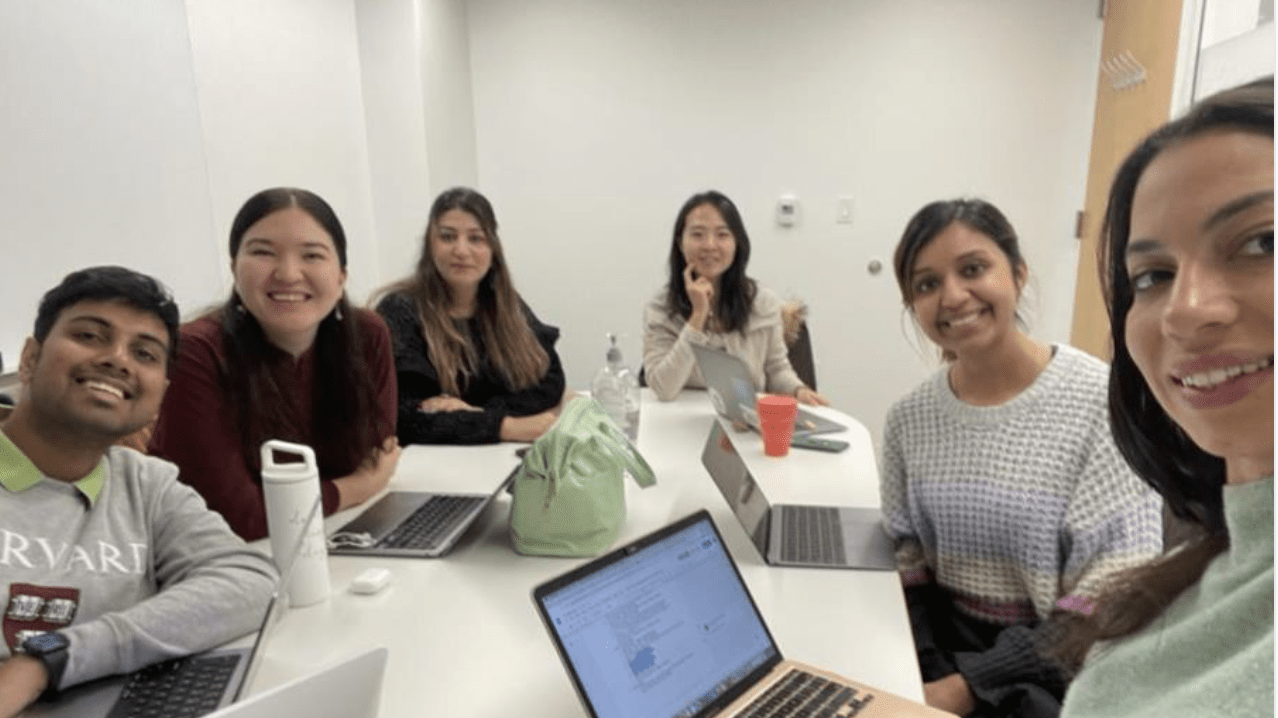Guest Blog by: Abby Yang, Amina Benzakour Knidel, Gulnaz Kordanova, Priyanka Varma, Sana Ikram, and Shashwat
These past seven weeks, the six of us, all from different personal and professional backgrounds, worked together to learn about and practice how to apply the problem driven iterative adaptation (PDIA) approach to a real-life issue. Specifically, we worked closely with Maggie Jones from Tarrant County Community Development to address challenges of affordable housing in Tarrant County, the third most populous county in Texas, where housing and transportation combined make up roughly half of the county residents’ average household income.
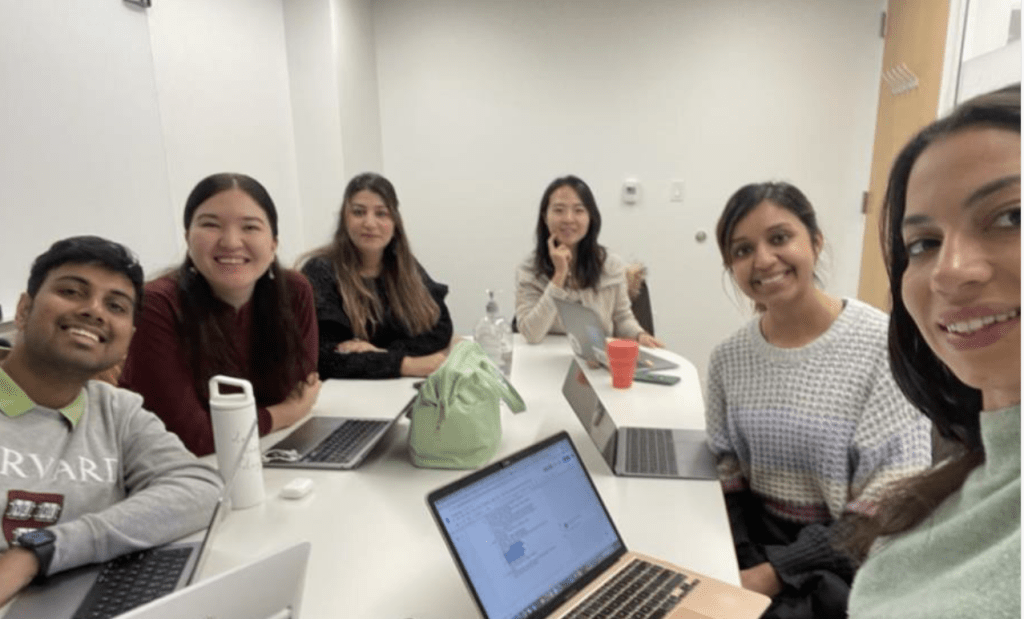
Key learnings about the PDIA process
By deconstructing the problem through the PDIA process, we discovered that our initial perspective on the problem was considerably limited in comparison to the actual breadth and complexity of the issue at hand. In fact, we realized that addressing the challenge of affordable housing in Tarrant County goes beyond affordability, it also encompasses inclusivity and accessibility issues. This process also compelled us to resist the urge to jump into solutions, a tendency that all of us exhibited prior to this course. We ultimately landed on the following problem statement: Households struggle to attain affordable, inclusive, and accessible housing in Tarrant County, Texas.
We then deconstructed the problem into a fishbone diagram which helped us dive deeper into the root causes of each aspect of the problem. These major causes included the following: (1) Tarrant County residents have limited availability of housing vouchers, (2) there are few developers interested in building affordable housing units, (3) there are few landlords willing to accept housing vouchers and rental assistance, and (4) available housing units are largely inaccessible.
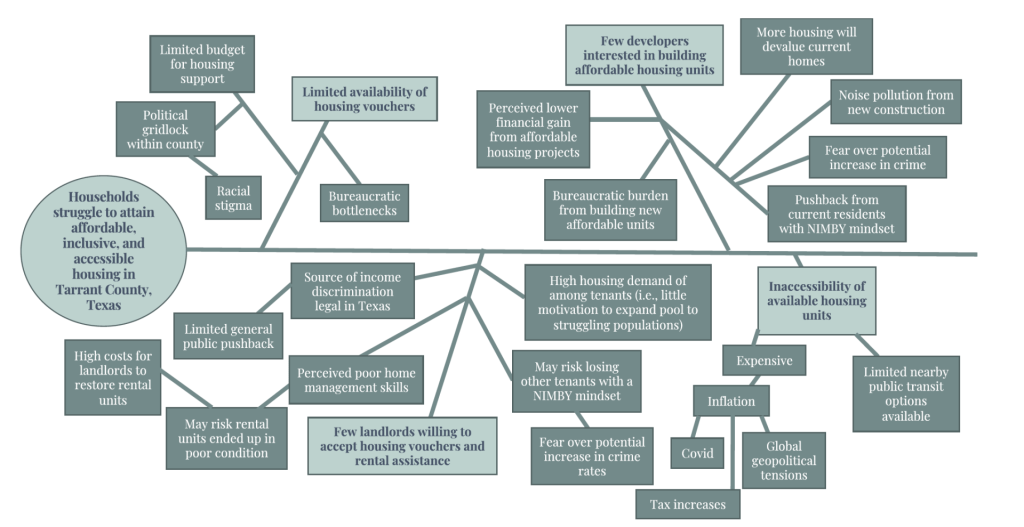
From there, we broke down each problem cause into related sub-causes, as seen in our fishbone diagram above. Identifying these root causes and sub-causes proved instrumental in conducting an AAA analysis, whereby we evaluated our authorizer’s level of authority, ability, and acceptance over each aspect of the issue. This step was crucial in helping us assess not only where our authorizer could act, but also how they should act. Based on this analysis, we identified four potential entry points where we felt there was scope for our authorizer to implement substantive change.
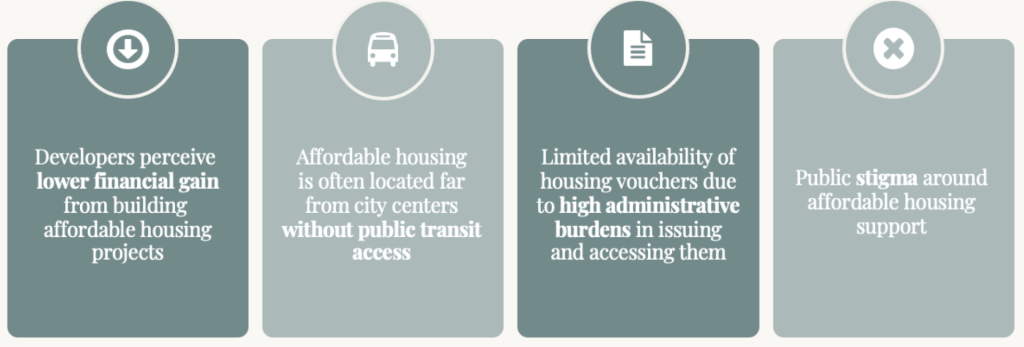
Over time, we honed in on two of them: (1) developers perceive lower financial gain from building affordable housing projects and (2) affordable housing is often located far from city centers without public transit access. These two entry points were critical in tackling the larger issue of affordable housing and where tangible actions could be taken.
Through this process, we learned that even issues with low levels of authority, ability, and acceptance could be addressed by taking small steps that could generate significant momentum to advance the larger cause. For instance, addressing the public transit problem proved challenging given Maggie’s low authority and ability over the issue, and a general lack of acceptance for public transit in the state of Texas. For this reason, we decided to concentrate on building coalitions with key stakeholders in the area rather than relying on achieving breakthrough solutions at this stage.
Throughout the process, we also engaged in individual as well as group conversations with various stakeholders, which enabled us to obtain diverse perspectives on the problem. We discovered that each group had distinct perceptions of the issue and held different opinions on the optimal solutions to address it. For instance, during conversations with various developers, we learned that affordable housing projects could be financially viable, but that the negative perception of the industry deterred many from undertaking such projects. On the other hand, some developers pointed out that construction costs and low rents in affordable housing were significant barriers to entry in this industry. Thus, our task was to reconcile these disparate perspectives and devise tangible solutions that catered to the varying interests and resources of each group. This process also underscored the value of iteration, which involves testing out our ideas quickly in order to receive feedback and incorporate it into our solutions, which is also one of our team’s key learnings from this course.
Major progress achieved through the problem-solving experience
As noted earlier, through the PDIA process, we honed in on two specific entry points for action. The first was around addressing developers’ perceived lower financial gain from building affordable housing projects, and the second was that affordable housing units are often located far from city centers and lack public transit access. To address these problems, we laid out two potential ideas and related action plans for our authorizer’s consideration.
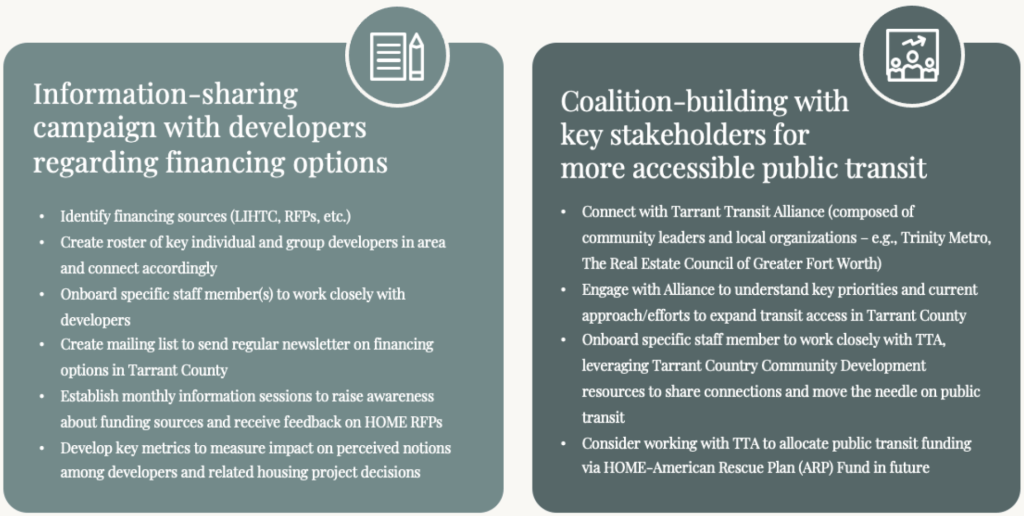
The first idea involved launching an information-sharing campaign with developers regarding financing options. For this, we recommended our authorizer connect with different Tarrant County-based developer organizations, including Fort Worth Housing Solutions, NRP Group, Presidium, and Streamline Advisory Partners, in order to address questions around financial gaps. The second idea involved building a coalition with key stakeholders in Tarrant County, notably the Tarrant Transit Alliance and Trinity Metro, to advocate for expanded public transit access to ultimately make the county’s available affordable housing units, often located far out from city centers, a feasible option for families working downtown.
We learned a lot about Tarrant County – the social, political, and economic landscape; the key stakeholders in the housing space and tangential sectors; and the community needs – through identifying ideas and designing high-level action plans for our authorizer. That being said, we also flagged a few key questions for her to further explore should she unpack these entry point ideas further, such as understanding how to make Tarrant County Community Development’s affordable housing development fund more attractive and accessible to developers, as well as exploring what the political steps look like for expanding public transit in Tarrant County.
Our advice for other students and practitioners
Over the past seven weeks, we learned a few key lessons which we would like to share with other students and practitioners. To begin, we believe that the key to successfully conducting the PDIA exercise is to have an open mind. It is natural to want to jump to search for a solution when addressing an issue. However, the PDIA process requires one to take a step back and look at the problem from a broader perspective – to unpack the problem statement and then deconstruct the problem and its various causes and sub-causes. Through the PDIA process’ systemic methodology, one can identify effective entry points. It is essential to trust this process – to have patience to chip away at the problem until one clearly understands the various components of the problem and feasible entry points at hand. While doing this, it is important to have the flexibility and ability to take a few steps back to evaluate the process. Iterations are an essential component of the process. It might also be the case that the problem statement itself would need to be altered, as our team experienced early on in the process.
It is also important to note that the PDIA process takes self-discipline and initiative. Learning from our positive experience, our advice to others is to engage with as many stakeholders as one can, read as many documents as one can, and ask as many questions as one can, all related to the problem at hand. The more effort that is put into the process, the more one can gain and move forward in effectively addressing the problem.
Overall, we had an excellent experience working together and with our authorizer on thinking through affordable housing challenges in Tarrant County, Texas. We are deeply grateful to our professors, Matt Andrews and Salimah Samji, for their guidance and support, as well as to our authorizer, Maggie Jones, for her time and patience these past seven weeks and an overall a fantastic experience together.
This is a blog series written by students at the Harvard Kennedy School who completed “PDIA in Action: Development Through Facilitated Emergence” (MLD 103) in March 2023. These are their learning journey stories.
